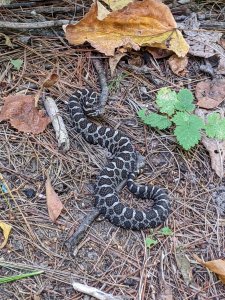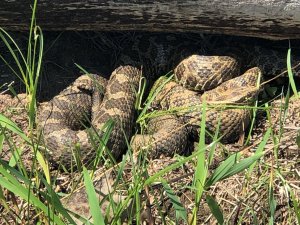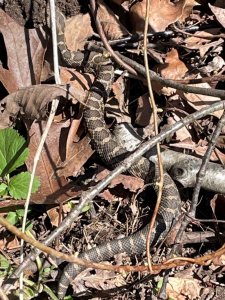The Secret Life of a Special Snake
May 31, 2023
Erin Parker, Interpretive Services Supervisor
One of the most secretive residents of southeastern Michigan’s moist soils and wetland edges may also be one of our most misunderstood residents as well. The Eastern Massasauga Rattlesnake is Michigan’s only venomous snake and like all snakes, plays a critical role in our local ecosystems. Mammals, such as voles, mice, moles, and shrews are their preferred prey and, despite their venom, they are consumed by everything from raccoons and foxes to hawks. However, the biggest threat to these shy snakes is habitat destruction as they require specific conditions to make it through their winter hibernation.

Phobias and misconceptions of and about snakes abound. But massasaugas truly have more to fear from humans than we have to fear from them! These shy reptiles can be found in some of the Metroparks, though they prefer to remain silent and unseen, letting visitors walk right by. Their blotchy patterns, typically a darker gray-to-grayish brown with light-colored edges, help them blend in their habitats, well camouflaged among leafy, dappled shade.

Hibernation and migration
Massasaugas have a unique life history in that they spend their winters hibernating in extremely wet areas below the frost line. They frequently use crayfish burrows or the tunnels made by chipmunks, moles, and other mammals or find their way under logs or rock piles. But what most of their hibernation sites have in common is water. Massasaugas may spend their hibernation period completely submerged and they specifically seek out places where the water table is near the surface and doesn’t freeze solid during Michigan’s coldest months. Suitable hibernacula, or shelters utilized by dormant animals, are one of the most important parts of their habitats. Hibernacula for each of Michigan’s snake species may be unique to that species but typically allow a snake, or snakes, to get under the cover of a jumble of rocks, roots, or other materials where they can safely spend the winter protected from extreme weather swings and hungry predators.
After spring water levels rise and temperatures warm up, many massasaugas then migrate short distances into drier upland areas for the summer months where they’ll breed and females will give birth to live young. In October, as the weather cools down, massasaugas will move back to their winter hibernacula. Studies suggest that while eastern massasaugas have high site fidelity for their hibernation sites, which means they return year after year to the same location, although they don’t necessarily return to the exact same burrow they used in previous winters.
This site fidelity, common in many animals including birds, mammals, and fish; means that even small changes to a specific habitat can have profound impacts on a species. Animals know their own home territories well – where to find food and water, hide from predators, and where they can find food and water. Work within our parks is done with careful planning to make sure that the important seasonal habitats of these snakes (and other wildlife!) remain protected. This also explains why relocating animals, such as snakes and turtles, more than about ¼ mile from where they were found is not recommended because relocated animals suffer much higher mortality rates than animals that haven’t been removed from their home sites.
Snake watching
Like all cold-blooded reptiles, including Michigan’s 18 species of snakes, eastern massasaugas are only active in the warmer months. Most visitors to our parks will never see these shy creatures and basic precautions mean that park patrons and venomous snakes can coexist peacefully! Never touch a snake that you can’t positively identify and make sure that children are taught to respectfully watch wildlife without approaching. This is safer for you and safer for the snakes. If you do observe a massasauga rattle snake while out on the trails, snap a picture from a safe distance and let interpretive center staff know- we keep records of massasauga sightings each year. If you’re not sure what you’ve observed, we can also help you with identification. Snakes deserve a safe place to live, particularly in our parks, so give them the space you need to feel comfortable.

Resources:
